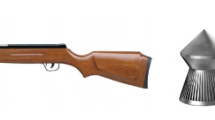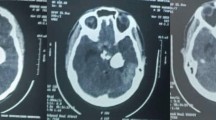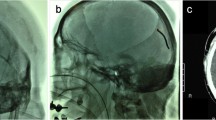Abstract
A 40-year-old drug addict, who was being treated with methadone and occupational therapy, committed suicide by striking a wooden pencil into his right eye socket. While still conscious, he hit his head hard against a table, jamming the pencil even deeper into his head. The autopsy showed that the pencil missed the globe and lodged in the inner part of the right eye socket. It pierced the orbital part of the right ethmoid bone, the right ethmoid cells, and the right superior nasal concha, then passed through the body of the sphenoid bone and the clivus of the occipital bone before stopping in the brain tissue. The basilar artery was transected at the pontomedullary junction, where the tip of the pencil had lodged. Also, at the pontomedullary junction, an approximately 3 mm deep laceration of the brainstem was evident together with flecks of green paint. Histological examination revealed that laceration at the pontomedullary junction was even deeper than the macroscopic appearance had suggested, with several small lateral cracks, focal deep hemorrhage, and disruption of both gray and white matter of the brainstem. Fragments of cellulose originating from the wooden pencil could also be clearly distinguished. Toxicological analysis was performed using liquid chromatography with mass spectrometry, and it showed traces of methadone in the blood and humor vitreous samples. The cause of death was damage to the vital structures in the brainstem, resulting from a penetrating injury to the head by a pencil. Herein, we present a self-inflicted trans-orbital penetrating injury by a non-missile, low-velocity object – a pencil, with a rather unusual, immediately incapacitating outcome.



Similar content being viewed by others
References
McKechnie J. A severe craniofacial impalement injury (Jael’s syndrome). Br J Oral Maxillofac Surg. 1986;24:258–64.
Shkrum M, Ramsay D. Forensic pathology of trauma – common problems for the pathologist. Totowa: Humana Press; 2007.
Turbin RE, Maxwell DN, Langer PD, Frohman LP, Hubbi B, Wolansky L, et al. Patterns of transorbital intracranial injury: a review and comparison of occult and non-occult cases. Surv Ophthalmol. 2006;51:449–60.
BouHaidar R, Lunyova ZM. A screwdriver in the skull: a case report of an unusual finding. Forensic Sci Med Pathol. 2005;1:61–3.
Tutton MG, Chitnavis B, Stell IM. Screwdriver assaults and intracranial injuries. J Accid Emerg Med. 2000;17:225–6.
Caldicott DG, Pearce A, Price R, Croser D, Brophy B. Not just another 'head lac'...Low-velocity, penetrating intra-cranial injuries: a case report and review of the literature. Injury. 2004;35:1044–54.
Oehmichen M, Auer RN, Koenig GK. Forensic neuropathology and associated neurology. Berlin: Springer; 2009.
Suess O, et al. Self-inflicted intracranial injury caused by a crossbow arrow. Eur J Trauma. 2002;28:310–3.
McCance KL, Huether SE. Pathophysiology—the biologic basis for disease in adults and children, 6th ed. London: Mosby; 2010.
Adams JH, Mitchell DE, Graham DI, Doyle D. Diffuse brain damage of immediate impact type. Its relation to “primary brain-stem damage”. Brain. 1977;100:489–502.
Kennedy BL, Feldmann TB. Self-inflicted eye injuries: case presentations and a literature review. Hosp Community Psychiatry. 1994;45:470–4.
Patton N. Self-inflicted eye injuries: a review. Eye. 2004;18:867–72.
Aksaray G, Erol S, Kaptanoglu C. Self-inflicted bilateral eye injury by a schizophrenic patient. Gen Hosp Psychiatry. 2000;22:215–6.
Ananth J, Kaplan HS, Lin KM. Self-inflicted enucleation of an eye: two case reports. Can J Psychiatr. 1984;29:145–6.
Funding
This work was supported by Ministry of Science of Republic of Serbia, Grant No. 45005.
Author information
Authors and Affiliations
Corresponding author
Ethics declarations
Conflict of interest
The authors hereby declare that they have no conflict of interest.
Ethical approval
This article does not contain any studies with human participants or animals performed by any of the authors.
Rights and permissions
About this article
Cite this article
Cvetković, D., Živković, V., Damjanjuk, I. et al. “The pen is mightier than the sword” – suicidal trans-orbital intracranial penetrating injury from a pencil. Forensic Sci Med Pathol 14, 221–224 (2018). https://doi.org/10.1007/s12024-018-9959-9
Accepted:
Published:
Issue Date:
DOI: https://doi.org/10.1007/s12024-018-9959-9




